What Is The Difference In Characteristics Of Pure Goods Versus Pure Services
Public goods, every bit the proper noun suggests, are for the facility and welfare of the public in general for free of cost. Whereas, private products are the ones which are sold past individual companies to earn profits and fulfil the needs of the buyers. This is a significant divergence between these two types of goods.
Notwithstanding, both public goods and private goods are for the consumer's benefit; they differ drastically from each other. Only, where public goods benefit the mass population, private products are only for those who have affordability. To know these differences in detail, read beneath.
Content: Difference Between Public Goods and Private Goods
- Difference and Comparison
- Types of Appurtenances
- What are Public Appurtenances?
- What are Private Goods?
- Advantages
- Disadvantages
- Summary
Difference and Comparison
| Footing | Public Appurtenances | Private Goods |
|---|---|---|
| Meaning | Public appurtenances are the ones which are provided by the nature or the authorities for complimentary use past the public. | Individual appurtenances are the ones which are manufactured and sold by the private companies to satisfy the consumer needs and wants. |
| Provider | Nature or government | Manufacturers i.east. entrepreneurs |
| Consumer equality | Rich and poor are treated equally | Preference to rich consumers |
| Availability | Readily bachelor to all | Reduces with each consumption |
| Quality | Remains constant | Varies with power to buy |
| Conclusion | Social pick | Consumer'southward decision |
| Objective | Overall growth and development | Profit earning |
| Traded in Free Market place | No | Aye |
| Opportunity Price | No | Yes |
| Gratis riders problem | Yep | No |
| Rivalry | Non-rival | Rival |
| Excludability | Not-excludable | Excludable |
| Demand Curve | Horizontal | Vertical |
| Examples | Law service, burn down brigade, national defense, public transport, roads, dams and river | Clothes, cosmetics, footwear, cars, electronic products and nutrient |
Types of Goods
Earlier we read about the different kinds of appurtenances bachelor, nosotros must clearly understand the meaning of the following two determinants of these types:
- Rivalry: Rivalry tin be perceived as contest in consumption i./e. If one person consumes a particular good, the other has to let go of the opportunity of using it simultaneously.
- Excludability: The term excludability refers to the restriction on the usage of a product limited to the people who take paid for it.
At present, by the above two attributes, the goods are categorized into the following iv types: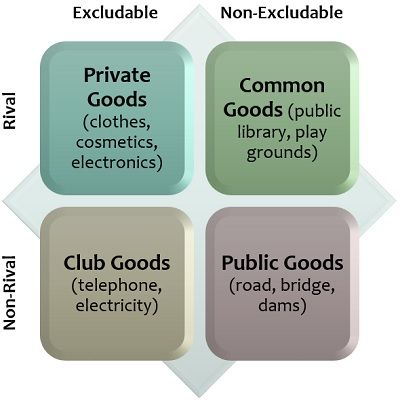
- Private Goods: The products which are rival and excludable at the same time as dress, cosmetics and electronics are termed equally private goods.
- Common Appurtenances: These appurtenances are though rival but are non-excludable, including a public library and playgrounds which can be used by anyone. Too, usage by one person or team restricts its usage by the other person or grouping.
- Club Goods: Such goods are though excludable but are not rival like the telephone and electricity which are both chargeable, merely many people tin relish these services simultaneously.
- Public Goods: The goods which are non-rival and non-excludable at the same time, for instance, road, bridge and dams are called public goods.
What are Public Appurtenances?
Public goods are the bolt or services provided past the nature of the regime of a country, costless of cost or by taxing the few people to offer mass do good to the public in full general.
Characteristics of Public Appurtenances
These commodities or services develop the infrastructure and living standard of a country. To know more than about public goods, permit us go through its following features: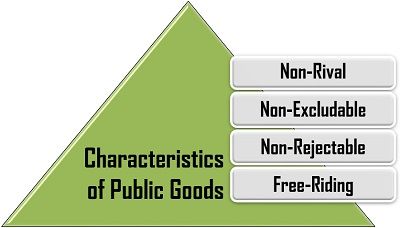
- Non-Rival: The public goods are not-competitive, i.e. it can serve many people at the same time without hindering the usage of i some other.
- Non-Excludable: These appurtenances are unremarkably free of cost and can be used by anyone without whatever restriction.
- Non-Rejectable: The consumption of such goods cannot exist dismissed or unaccepted by the public since it is available collectively to all the people.
- Free-Riding: The appurtenances categorized under public goods do good even those who have non paid for it. Such people are termed as gratis-riders.
What are Individual Goods?
Private appurtenances are the products or services which are manufactured or produced by the companies owned by entrepreneurs who aim at meeting customer's requirement to earn profits through the trading of such goods in the free market place.
Characteristics of Private Goods
Private goods serve the personal needs of consumers. Following are the diverse characteristics of these appurtenances: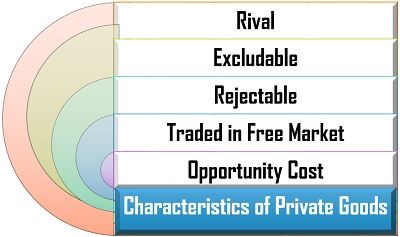
- Rival: The private products involve rivalry or competition amidst the consumers for its usage since the consumption by one person will restrict its use past another.
- Excludable: These appurtenances involve price, and therefore the non-payers are excluded from the consumption.
- Rejectable: Private appurtenances can be unaccepted or rejected by the consumers since they have multiple alternatives and the right to select the product according to their preference.
- Traded in Gratuitous Market: Such goods tin can be freely bought and sold in the market at a given price.
- Opportunity Cost: These appurtenances have an opportunity, i.e. the consumer has to let go of the benefit from a similar product while selecting a particular private commodity.
Advantages of Public Goods
Public goods carry the mass benefit for the people. They accept a broader perspective.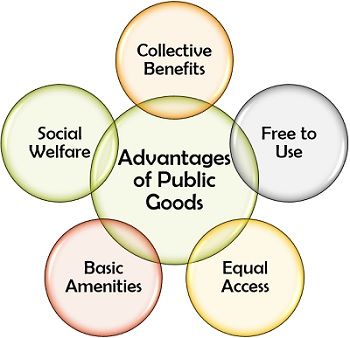
These goods can be used by many people or the public simultaneously. These are unremarkably gratis of toll and can be utilized by the rich and poor every bit.
The principal objective of such goods is to provide essential amenities to the public in general, along with promoting social welfare and development of the nation as a whole.
Advantages of Private Goods
These goods accept a common benefit for the manufacturers and the consumers; both serve their purpose through the selling and buying of such products respectively.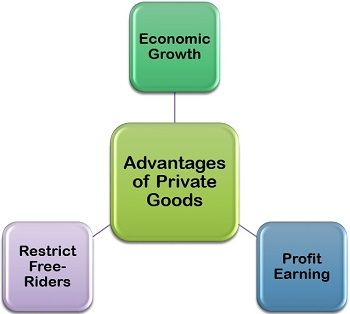
Private goods are essential to carry on trade activities for economic development. It is done with the motive of earning a turn a profit from the entrepreneurs.
Such goods restrict the consumption by the people who do not take ownership chapters, thus limiting its usage by the rich in other words it discourages the gratuitous-riders.
Disadvantages of Public Goods
Permit usa run into some of the limitations of public goods, elaborated below: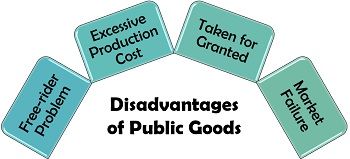
For providing public appurtenances to exist used by all the people, government charges taxation from a few consumers while the others are gratis to use the services or commodities even without paying for information technology. They are called complimentary-riders. Some as well observe a way for taxation evasion. This increase the cost of production of such products for the government and leads to market place failure.
Moreover, these facilities or benefits are taken for granted and misused or not maintained by some people since they have not paid for it and did not realise its value.
Disadvantages of Private Appurtenances
Now, to detect out the drawbacks of private goods, read below: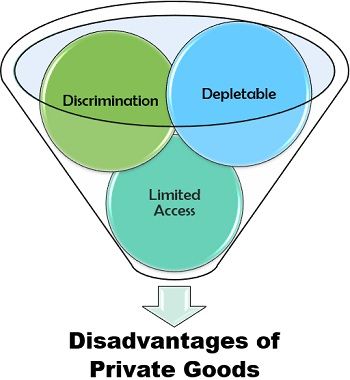
Private goods are manufactured by the individual sectors, and therefore they role on need and supply concept. These products or services goes on decreasing with each utilise since the appurtenances bought by one consumer cannot be purchased by the other.
These appurtenances create discrimination among the rich and the poor or the payers and the non-payers since they limit the admission for those who don't have purchasing power.
Summary
- Public goods are produced by the government or by nature for the welfare of the people without any cost. But private products are the ones manufactured and sold by private companies to earn a profit.
- When nature or the regime provides public goods, private goods are produced by the businessmen or the entrepreneurs.
- In the case of public goods, rich or poor can equally benefit from such goods. Whereas, in fact of private products, merely rich people who accept the purchasing power can relish its benefits.
- The one-time is readily bachelor and accessible by all the public. However, the latter diminishes with the consumption of each unit by the consumers.
- The quality of public goods remains constant for all consumers. But, the quality of individual goods vary as per the purchasing power, i.e. more than purchasing power means a meliorate quality of the product.
- Public appurtenances are a social choice, i.eastward. it aims at benefiting society equally a whole. Whereas, private products is a consumer'due south preference and determination-based on individual needs.
- The primary objective of the former is the growth and development of the land; however, the latter aims at profit earning by the entrepreneurs.
- Public appurtenances cannot exist traded in the gratuitous market, whereas private products are sold in the open market only.
- When public goods accept no opportunity cost, private appurtenances have an opportunity toll where the person choose 1 production over the other.
- Public goods are bachelor to even those who did not pay whatever tax known every bit free-riders, whereas the aforementioned is not the instance in private products.
- The former is non-rival, i.east. information technology is available and can be used equally by all the public at the aforementioned fourth dimension. However, the latter is rival and cannot exist used by the ii or more people simultaneously.
- Public goods do not discriminate or restrict people past the buying capacity; these are freely assessable by all. On the contrary, private appurtenances are excludable and prevent its consumption by the people who don't accept purchasing power.
- The demand bend for public goods is horizontal, whereas the demand curve for private products is vertical.
- The various examples of public goods are police service, fire brigade, national defence, public transport, roads, dams and river. On the opposite, clothes, cosmetics, footwear, cars, electronic products and nutrient are examples of private goods.
Both the goods, public and private are essential for the evolution of a state.
Public goods are a necessity to provide the essential amenities to the people for improving the quality of life.
Individual goods are equally essential to meet the consumer needs and requirements, enhance the merchandise activities in a country and promote economic development.
What Is The Difference In Characteristics Of Pure Goods Versus Pure Services,
Source: https://theinvestorsbook.com/public-goods-vs-private-goods.html
Posted by: robertstans1957.blogspot.com


0 Response to "What Is The Difference In Characteristics Of Pure Goods Versus Pure Services"
Post a Comment